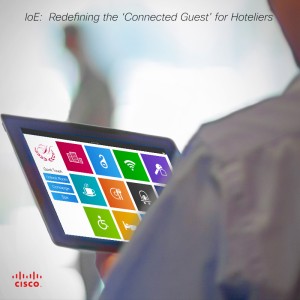































When a person is considered tech-savvy and "always-connected" in their day-to-day life, these expectations don't change when they stay in a hotel. In fact, this new "connected hotel guest" actually expects the same mobile experience at hotels that they receive at home or work. Hoteliers across the world are constantly trying to find ways to meet the increasing needs of the mobile-connected guest. Previously, hotel Wi-Fi was used primarily for guests and staff connectivity, but now, it's becoming much more than that because of these guests' needs.Wi-Fi will play a significant role in introducing the Internet of Everything (IoE) to hotels, meaning connecting devices, places, people and data throughout hotel properties. At Cisco, we talk a lot about IoE and the future it's creating, but do we really understand IoE's impact on hoteliers and the future of hospitality?
The IoE brings people, processes, data, and things together to make networked connections more relevant and valuable than ever before, and its impact is no different at hotels than it is at your home, at work or in your car. Through IoE, information is turned into actions that create new capabilities, richer experiences and unprecedented economic opportunity for businesses, individuals and countries. We are going to start to see the hospitality industry benefit from IoE as it's on the forefront of utilizing it to enhance the guest experience and increase operational efficiency.
The guest experience at hotels continues to evolve as the guests become more mobile and experienced technology-savvy travelers. Hotels are adding more mobile-friendly technologies to the rooms to enhance the guest experience, so it's important for hoteliers to provide a common platform to allow all of the IP-enabled devices to communicate with each other. In other words, door locks, thermostats, set-top-boxes, mini-fridges, telephones, light switches and electric blinds and other devices must all be connected on a common network to enable the services that guests want. And in addition to a single network, the more hoteliers can automate various sensors within properties with guest/staff info -the better the experience, driving greater customer loyalty.

These new connections will help hoteliers drive business and operate more efficiently. Now that both people and things are connected to the network, hoteliers can capture and understand guest-generated data to drive the next level of intelligence and automation. I believe in the near future that hoteliers will need to develop a strategy to collect and manage large amounts of information from multiple properties and derive business intelligence to personalize the guest experience in real-time.
To really tell the IoE story at the hotelier level, I need to go into details about specific use cases. In my next blog post, I will outline some of the IoE examples that we believe are in our near future and how it will continue to enhance the guest experience through increased connections. Until then, use the comment section below to provide some of your ideas for future use cases of IoE in hospitality.
For more information on how Cisco is helping hoteliers adapt to IoE and the connected guest experience, visit cisco.com/go/hospitality.
 Tags quentes :
Internet of Everything (IOE)
IoE
dados
location
hospitality
Connected
hotel
location-based
hotelier
Tags quentes :
Internet of Everything (IOE)
IoE
dados
location
hospitality
Connected
hotel
location-based
hotelier